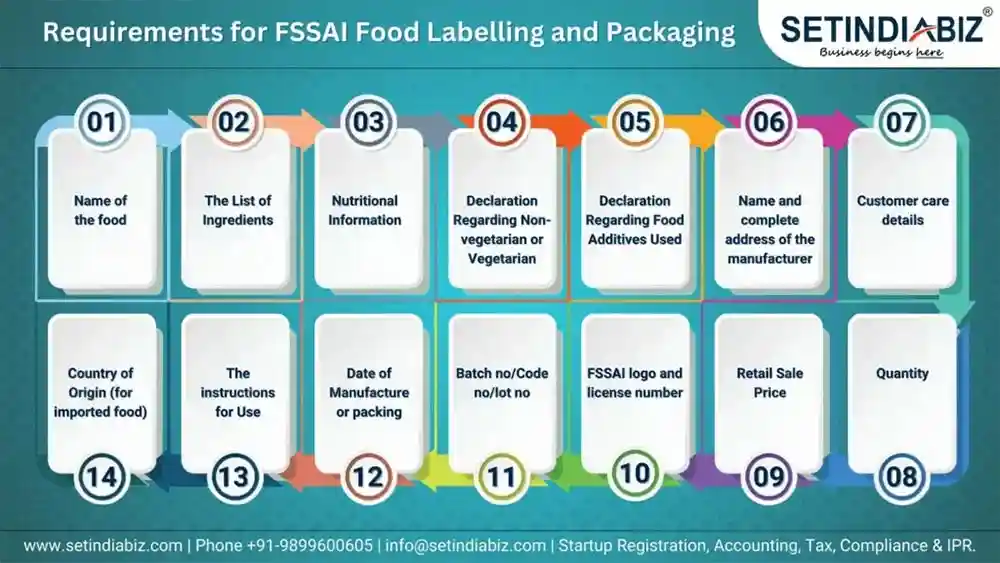FSSAI Food Labelling & Packaging Requirements – A Complete Guide
FSSAI Food Labelling and Packaging Guidelines ensure complete legal compliance for your food business. Read our complete guide for details.
Government agencies all over the world have rigorous labelling and packaging standards in place to ensure quality, compliance and safety of food products. In India, FSSAI is the ultimate regulatory authority which is responsible for doing so! Every FBO registered or licensed by the FSSAI has to comply by food labelling and packaging guidelines it has set forth, as non-compliance would mean imposition of severe penalties and in certain circumstances the revocation of FSSAI License or registration. Moreover, FSSAI food labelling compliance also helps avoid misunderstandings among different stakeholders in the supply chain including manufacturers, traders, and sellers of food products.
Strict adherence to food labelling FSSAI standards is essential for all food products to ensure clear communication of product specifications and safety information to consumers as well. While these standards aim to enhance safety and transparency, they can also pose a risk of errors, potentially leading to fines, penalties, product recalls, and launch delays in the event of non-compliance. However, a comprehensive understanding of FSSAI Food Labelling guidelines is your key to navigating these challenges and maintaining compliance, keeping your products free from these concerns.
What are the FSSAI Food Labelling and Packaging Requirements?
Understanding the guidelines of food labelling FSSAI requirements is essential for every food business. In this section, we will walk you through all the guidelines one by one. These guidelines are crucial to ensure that your food products are compliant, safe, and informative for consumers.

1. Name of the food
The product name should be printed on the product according to FSSAI food and labelling standards. Furthermore, the name should be written in an acceptable font and in a manner that is easy to understand.
2. The List of Ingredients
The product must declare all of the ingredients used in its manufacturing. The manufacturer must list all of the ingredients used in the process so that the customer is cognizant of them. It is strongly recommended to keep customers away from dark areas and ingredients that they are unfamiliar with.
3. Nutritional Information
Include information on the calorie content of the food product. The nutritional calories received from trans fat, saturated fat, sodium, cholesterol, dietary fibre, carbohydrates, protein, sugar, iron, calcium, vitamin A, vitamin C, and so on, contained per 100gm or 100ml must be provided, as well as the energy value in kcal, amount of protein, carbohydrate, fat, minerals, vitamins, and so on, in the product
4. Declaration Regarding Non-vegetarian or Vegetarian
Reveal whether a food product contains non-vegetarian or vegetarian ingredients. A sign in red for non-vegetarians and green for vegetarians must be present in every corner of the food product to identify whether it is vegetarian or non-vegetarian.
5. Declaration Regarding Food Additives Used
Additives are frequently used in the production of any food item to improve the taste, colour, or preserve it. The additives used in the manufacturing / processing of a food product must be declared by the maker. It must be printed on the label in a prominent spot.
6. Name and complete address of the manufacturer
The maker must include his full name, address, and the location where the food product is created. It should be mentioned in a prominent and obvious location on the label.
7. Customer care details
It is necessary to give customer care information on the food product label. To clarify any query, the consumer may contact the product manufacturer’s customer service.
8. Quantity
The quantity and the net quantity of the food product should be specified on the label.
9. Retail Sale Price
The FSSAI food labelling guidelines require that the final retail price at which the food product is sold be indicated.
10. FSSAI logo and license number
The FSSAI emblem and licence number must be mentioned on the label, according to FSSAI food labelling requirements.
11. Batch no/Code no/lot no
The purpose behind using these numbers in the packaging as per the FSSAI food labelling guidelines is to offer legitimacy to the manufacturer. As a result, the batch number, code, and lot number should be listed on the food product’s label.
12. Date of Manufacture or packing
The date of manufacturing is a crucial declaration that should be written on the food product. It is extremely important since it directly relates to the consumers’ ability to consume food that has not expired. Consuming expired food may result in major health problems. The manufacturer must, however, include the date of manufacture.
13. The instructions for Use
It is mandatory for the FBO to mention the directions prescribed to use a particular product. It should be visible on the label and stated in the appropriate language.
14. Country of Origin (for imported food)
Every food product must display its nationality according to FSSAI food labelling standards. It will increase customer awareness and assist them in comprehending where the food was produced, manufactured, or processed.
Why Are Food Labelling FSSAI Requirements Crucial?
Health concerns about packaged foods have risen dramatically in recent years. This is the reason why food labelling FSSAI requirements were introduced in the first place. Complying with these requirements works as a credible information source for consumers about the quality and safety of pre-packaged foods. Besides, it is legally mandatory to follow these requirements to avoid penalties and revocation of food business licence / registration.
As soon as a food product is ready for sale in the market, it must be properly packaged and labelled with information such as ingredients, vegetarian /non vegetarian, calories, date of manufacture, and so on, as per the food labelling FSSAI guidelines discussed in the above section. FSSAI Labelling must be done on the packaged food item using either printed or pictorial information.
Let’s understand the importance of FSSAI Food Labelling with an example!
Let’s suppose, as a customer you went to a store to buy a bag of rice. You are oblivious to the product’s composition. So, you take the package and read the ingredients list printed on it. This gives you full information of what the product is actually made of, how nutritious it is, and whether it is safe from the perspective of human health.
Further more, complying with the food labelling FSSAI requirements not only benefits the buyer but also allows producers to exhibit and inform consumers about their product’s quality. It’s an excellent way to highlight an important aspect of the manufacturing process and gaining a competitive edge in the market. Food labelling must not contain misleading, false, or deceptive descriptions, as it would defeat the entire purpose of introducing FSSAI labelling and packaging guidelines in the first place.
How Setindiabiz Helps in Following FSSAI Food Labelling Guidelines?
At Setindiabiz, we excel in providing expert legal consultation to food business and startups regarding all the FSSAI compliances they have to fulfil. We assist in applying for the necessary FSSAI License and registration and guide businesses through all the FSSAI Food labelling and packaging requirements to ensure easy and seamless sale of food products. For more information, you can contact our advisors!
Conclusion
In the world of food business, adhering to FSSAI food labelling standards is not just a legal requirement but a commitment to consumer safety and transparency. By understanding and implementing these food labelling FSSAI regulations, you not only ensure compliance but also build trust with your customers. Clear and informative labels not only benefit your business but also contribute to the overall safety of the food industry. Stay diligent with FSSAI food labelling to create a reliable and responsible food business that stands out in the market.
FAQ's
Author Bio

Editorial Team | in
Setindiabiz Editorial Team is a multidisciplinary collective of Chartered Accountants, Company Secretaries, and Advocates offering authoritative insights on India’s regulatory and business landscape. With decades of experience in compliance, taxation, and advisory, they empower entrepreneurs and enterprises to make informed decisions.
